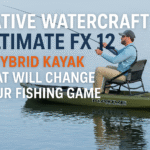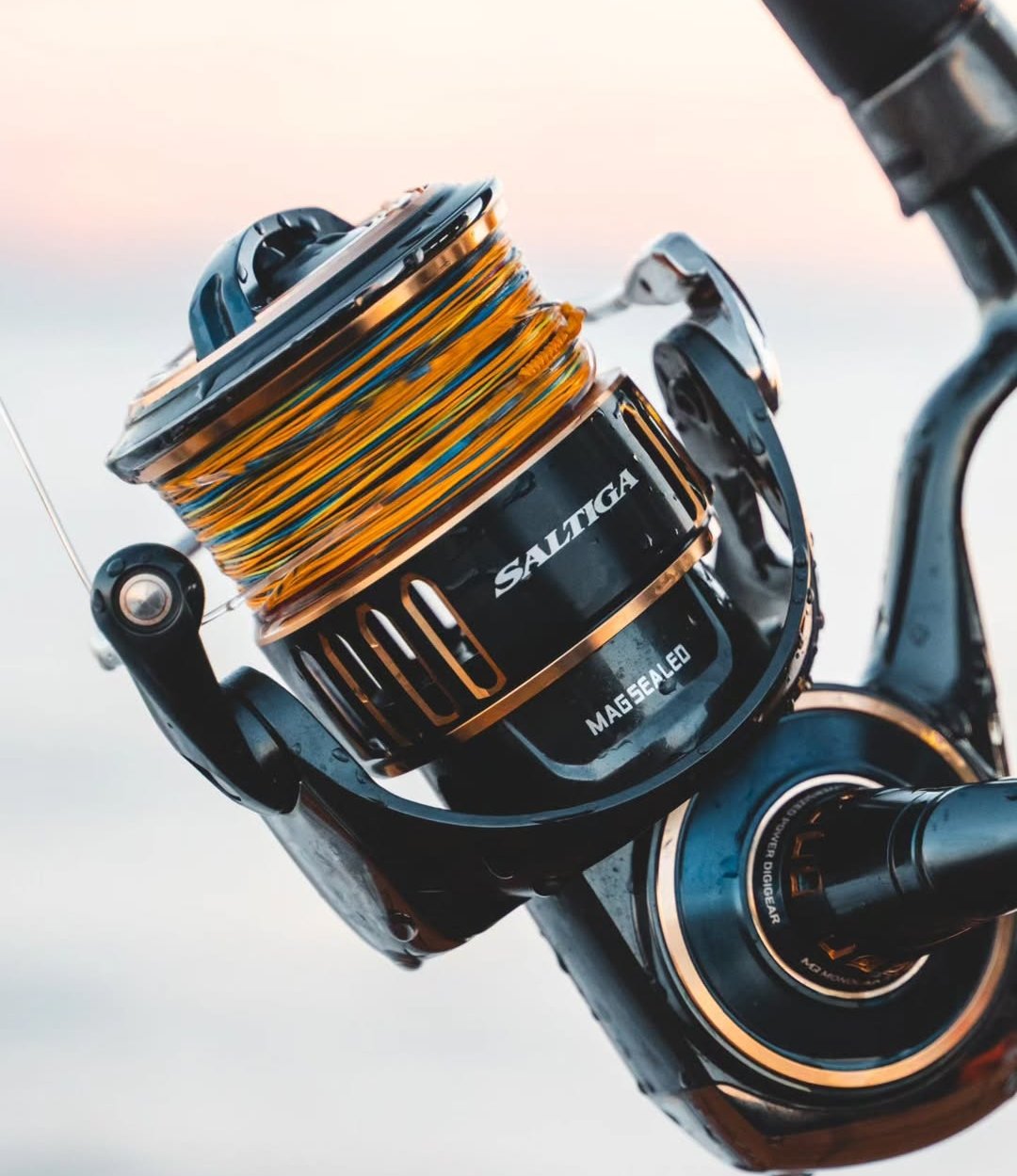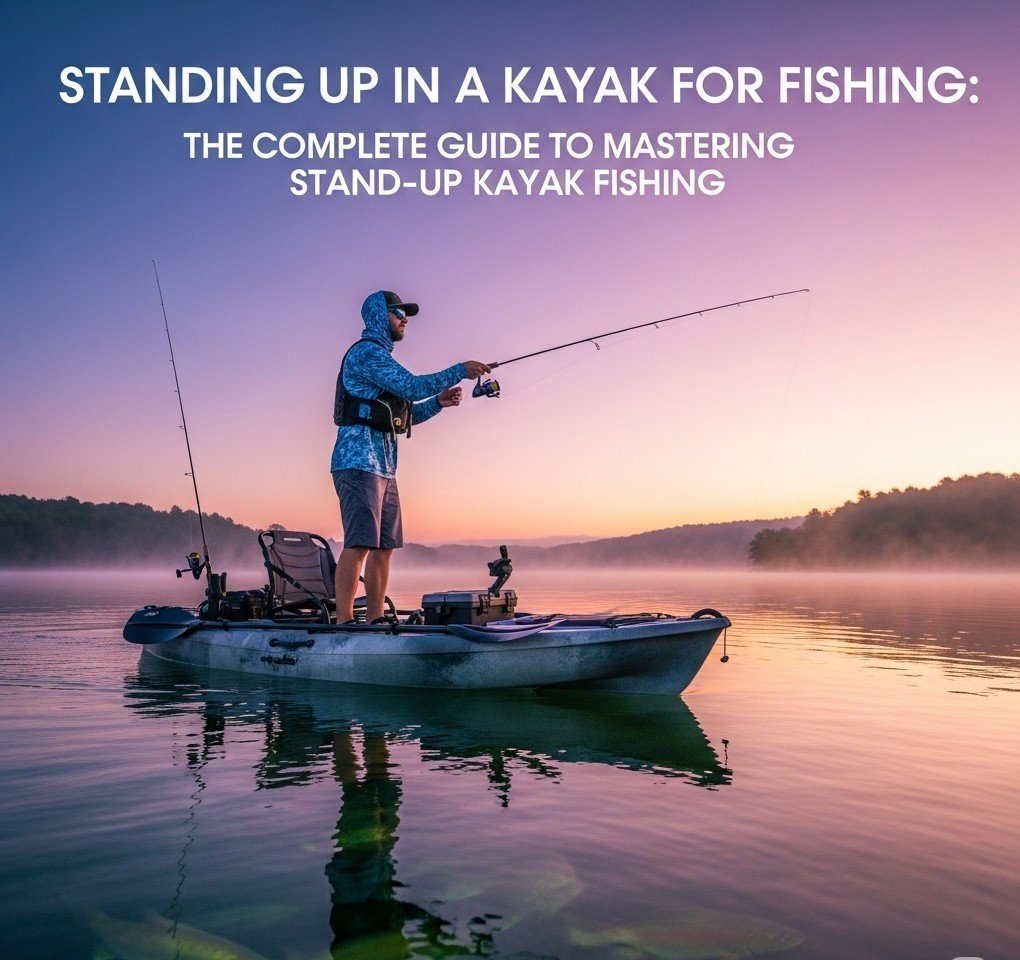
Did you know that anglers who master standing up in a kayak for fishing report catch rates up to 40% higher than those who remain seated? This dramatic improvement isn’t just luck—it’s the result of enhanced visibility, superior casting mechanics, and better fish-fighting leverage that only stand-up kayak fishing can provide.
Stand-up kayak fishing has revolutionized the angling experience, transforming how fishermen approach everything from shallow water sight fishing to deep water casting. This comprehensive technique allows anglers to elevate their perspective literally and figuratively, opening up fishing opportunities that were previously impossible from a seated position.
Key Takeaways
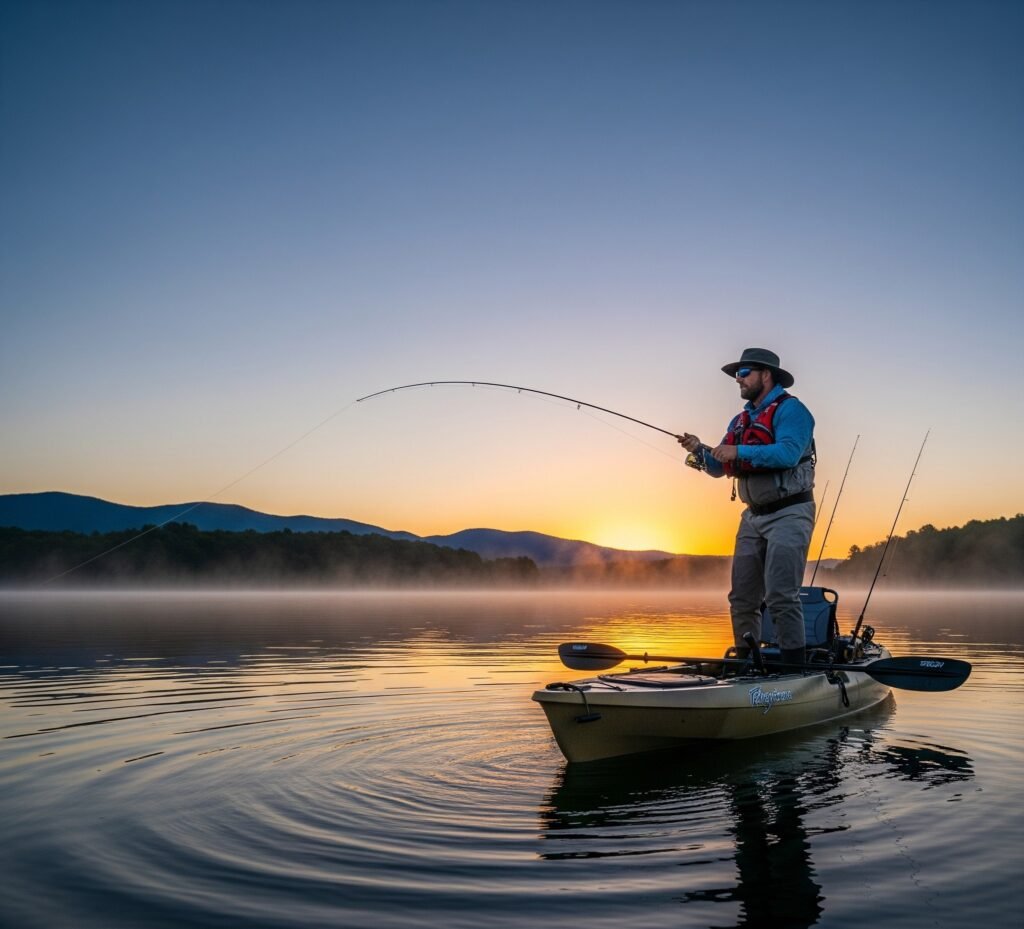
- Enhanced Visibility: Standing increases sight fishing range by up to 50%, allowing you to spot fish, structure, and feeding activity from greater distances
- Improved Casting Performance: Elevated position provides 25-30% increase in casting distance and significantly better accuracy
- Superior Hook-Setting Power: Vertical positioning delivers biomechanical advantages for stronger, more effective hook sets
- Better Fish Control: Standing position offers enhanced leverage during fish fights, reducing escape rates by approximately 20%
- Equipment Selection is Critical: Kayaks with 34+ inch beam width and specialized stability features are essential for safe standing
Why Standing Up in a Kayak for Fishing is Game-Changing
🎯 Visibility Advantages
Standing transforms your kayak into a mobile observation platform, providing 360-degree sight fishing opportunities that seated anglers simply cannot access. From an elevated position, you can identify fish movements, underwater structure, and feeding patterns that remain invisible at water level. This enhanced perspective allows you to spot redfish tailing in shallow flats, bass cruising near structure, or baitfish schools that indicate predator activity below.
Research shows that standing can increase your sight fishing range by up to 50%, dramatically expanding the water you can effectively fish during each outing. The ability to see deeper into the water column and farther across the surface gives stand-up anglers a significant tactical advantage.
🎣 Casting Benefits
The elevated casting position delivers substantial improvements in both distance and accuracy. When standing, your casting stroke utilizes full body mechanics, engaging core muscles and allowing for longer rod travel. This biomechanical advantage typically results in 25-30% increased casting distance compared to seated fishing.
Accuracy improvements are equally impressive. The higher vantage point allows for better target identification and trajectory planning, while the stable standing platform enables more controlled casting motions. Anglers consistently report improved precision when casting to specific structure, feeding fish, or tight spots that require pinpoint accuracy.
⚡ Hook-Setting Power and Fish Fighting Control
Standing provides superior biomechanical advantages for hook setting and fish fighting. The vertical positioning allows anglers to generate more power through their entire body, creating stronger, more decisive hook sets that significantly reduce fish losses during the initial strike.
During fish fights, the standing position offers enhanced leverage and control. Anglers can use their full body weight and positioning to manage fish movements, apply consistent pressure, and maintain better rod angles throughout the battle. This improved control typically reduces fish escape rates by approximately 20% compared to seated fishing.
Essential Fishing Kayak Features for Standing Up
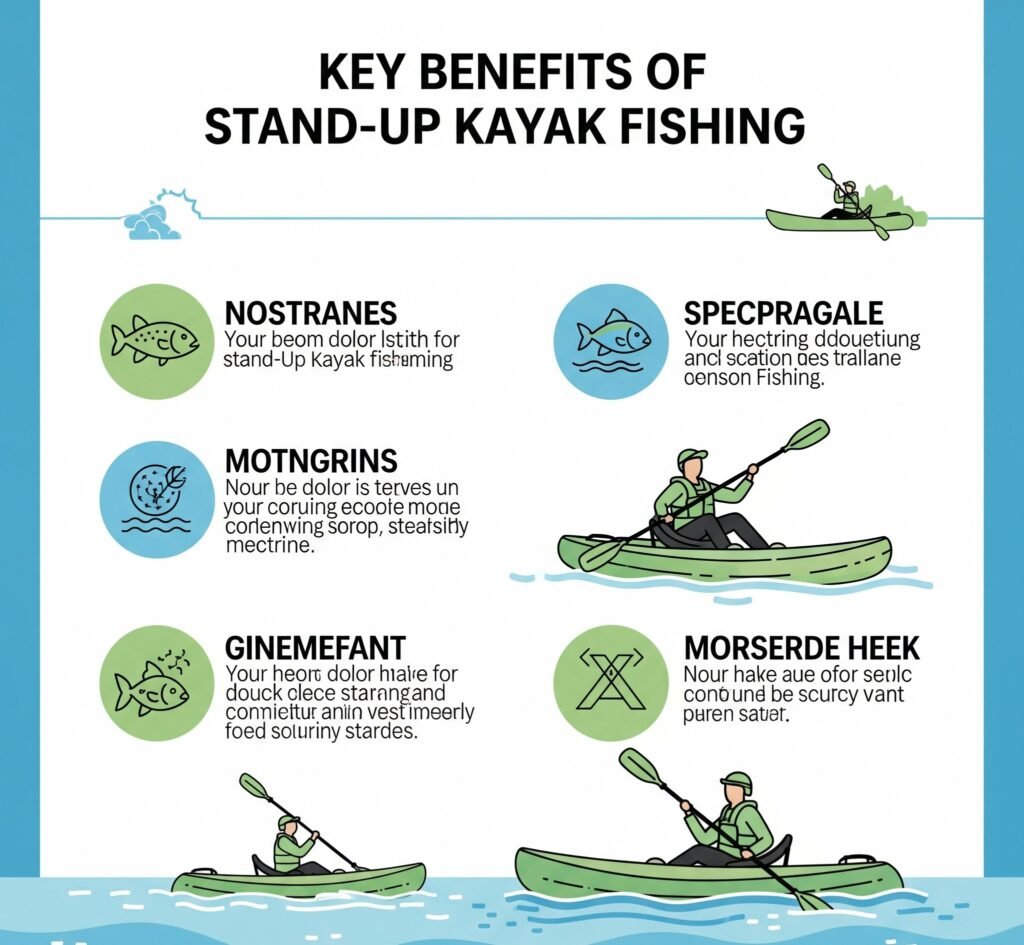
🛶 Primary Stability Requirements
Fishing kayak stability begins with proper beam width. For safe standing, kayaks require a minimum 34-inch beam, though 36+ inches provides significantly better stability for most anglers. This width creates the initial stability necessary to support an angler’s weight shift during the standing transition.
The hull design plays an equally critical role. Pontoon-style hulls offer excellent primary stability, making them ideal for beginners learning to stand. These designs feature wide, flat bottoms that resist tipping during initial weight shifts.
⚖️ Secondary Stability and Hull Design
Secondary stability determines how the kayak behaves when tilted beyond its initial stability point. Catamaran-style hulls excel in this area, providing a progressive stability curve that gives anglers confidence when leaning or reaching while standing.
Multi-hull designs, such as those found in premium fishing kayaks, combine the benefits of both primary and secondary stability. These kayaks feature wider beam measurements with specialized hull shapes that maintain stability across a broader range of conditions.
🏗️ Standing Platform and Deck Features
A proper standing platform requires flat, textured deck areas positioned at the kayak’s center of gravity. The platform should measure at least 24 inches in length and feature non-slip texturing to prevent foot slippage during standing transitions or while casting.
Textured deck areas should extend beyond the immediate standing zone to provide secure footing during movement. Many premium kayaks feature specialized deck materials that maintain grip even when wet, ensuring safety during extended standing sessions.
🤝 Stand-Assist Features
Modern fishing kayaks incorporate grab rails, standing straps, and stability aids specifically designed to facilitate safe standing transitions. Grab rails positioned along the gunwales provide secure hand holds during the standing process, while standing straps offer additional support for maintaining balance.
Stability aids include features like adjustable foot braces, knee wells, and ergonomic deck contours that help anglers maintain proper positioning. These features significantly reduce the learning curve associated with stand-up fishing techniques.
⚖️ Weight Capacity and Performance
Higher weight capacity directly relates to stability performance. Kayaks rated for 400+ pounds typically offer better stability characteristics than those with lower ratings, even when supporting lighter anglers. This relationship exists because higher capacity kayaks feature more robust construction and larger displacement hulls.
💰 Price Categories and Model Examples
Entry Level ($800-$1200): The Pelican Catch Mode 110 offers excellent stability features for beginning stand-up anglers, featuring a 32-inch beam and stable pontoon hull design.
Mid-Range ($1200-$2000): The Bonafide SKF117 provides enhanced stability with its 34-inch beam and specialized standing platform, making it ideal for intermediate anglers developing their standing skills.
Premium ($2000+): The Hobie Pro Angler 12 360XR represents the pinnacle of stand-up fishing design, featuring a 38-inch beam, advanced stability systems, and comprehensive standing aids. The Bonafide PWR129 offers similar premium features with its innovative hull design and extensive standing platform.
Step-by-Step Stand-Up Fishing Techniques
✅ Pre-Standing Checklist
Before attempting to stand, ensure calm water conditions with minimal wind and wave action. Secure all loose gear and ensure your paddle is positioned across your lap or secured in paddle holders. Verify that your personal flotation device is properly fastened and that your feet are positioned correctly on the standing platform.
Proper foot placement involves positioning feet shoulder-width apart on the textured deck area, typically just behind the seat. Ensure your weight is centered and that you have clear access to grab rails or standing assists.
📈 The Rise Sequence
Standing up in a kayak for fishing requires a systematic approach that prioritizes safety and control:
- Start in seated position with paddle secured across your lap and hands positioned on gunwales or grab rails
- Place hands on standing rails or gunwales, ensuring a secure grip before any weight transfer
- Move to kneeling position first – this intermediate step allows you to assess balance and stability before full standing
- Rise slowly using leg muscles rather than pulling with your arms, maintaining low center of gravity during transition
- Find center balance point by making small adjustments until you feel stable and controlled
⚖️ Maintaining Balance and Kayak Casting Position
Weight distribution is critical for maintaining stability while standing. Keep your weight centered over the kayak’s widest point and avoid sudden movements that could upset balance. Micro-adjustments through small foot movements and core engagement help maintain stability during casting and fish fighting.
Breathing techniques play an important role in balance maintenance. Controlled, steady breathing helps maintain core stability and reduces tension that can lead to balance issues. Focus on smooth, rhythmic breathing patterns while standing.
The optimal kayak casting position involves slight knee flex, engaged core muscles, and feet positioned shoulder-width apart. This athletic stance provides the stability and power transfer necessary for effective casting while maintaining balance.
⬇️ Safe Descent and Common Mistakes
Safe descent reverses the standing process with equal attention to control and safety. Lower yourself to the kneeling position first, then transition to seated position while maintaining three points of contact with the kayak.
Common beginner mistakes include:
- Rising too quickly without proper balance assessment
- Relying on arm strength rather than leg muscles during transitions
- Attempting to stand in inappropriate water conditions
- Failing to secure gear before standing attempts
- Neglecting to practice in controlled environments
Advanced Stand-Up Fishing Strategies
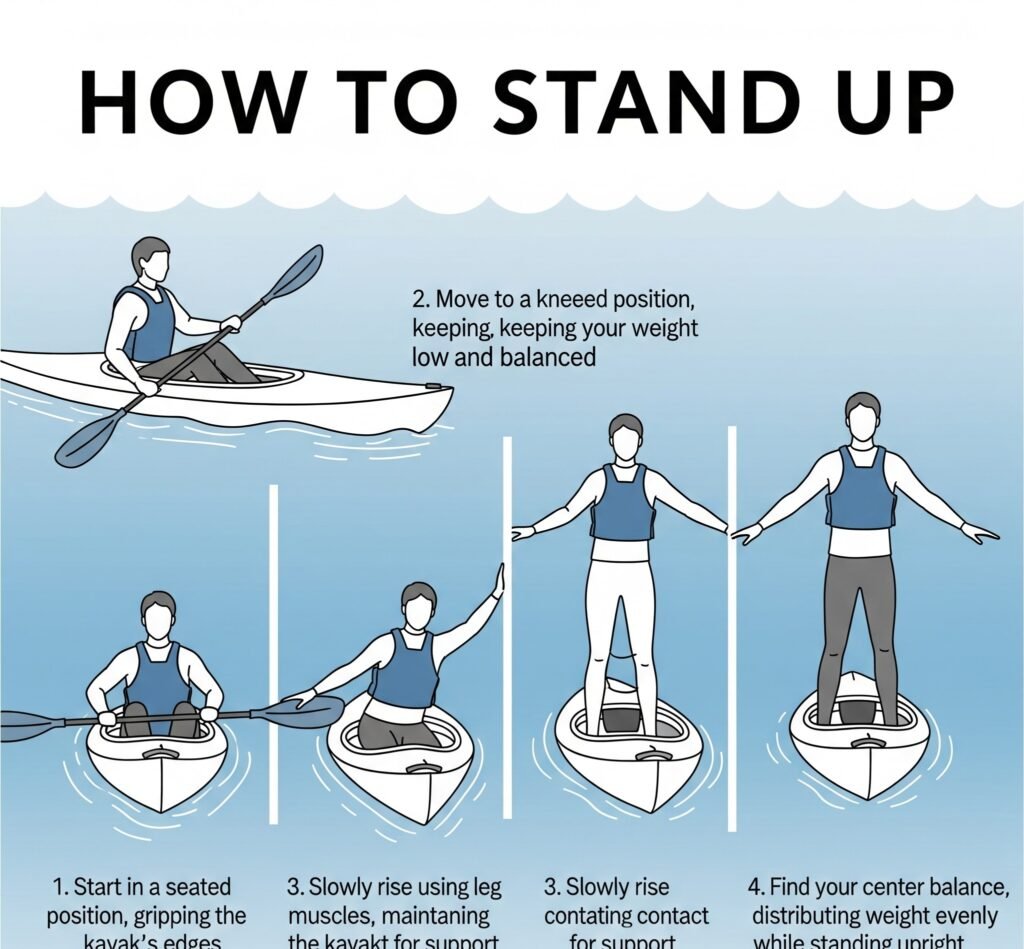
🌪️ Wind Management and Positioning
Wind management becomes critical when standing, as the elevated position increases wind exposure. Position your kayak so prevailing winds push you toward productive fishing areas rather than away from them. Quartering winds (45-degree angles) often provide the best compromise between stability and fishing effectiveness.
Use your standing position to read wind patterns on the water surface, identifying calmer areas or wind shadows that provide better fishing conditions. Advanced anglers learn to use wind direction to their advantage, allowing natural drift to present baits more effectively.
🌊 Current Reading and Structure Identification
The elevated perspective allows for superior current reading and structure identification. From a standing position, you can identify subtle current breaks, underwater structure, and depth changes that remain invisible to seated anglers.
Fish-holding structure becomes more apparent when viewed from above. Standing anglers can spot submerged logs, rock piles, vegetation edges, and depth transitions that concentrate fish. This enhanced structure identification dramatically improves fishing success rates.
🤫 Stealth Approach Techniques
Minimizing noise and movement while standing requires practice and awareness. Avoid sudden movements that create noise or vibrations that can spook fish. Learn to shift weight smoothly and maintain quiet foot placement on the deck.
Stealth positioning involves using the standing height advantage to spot fish before they detect your presence. This allows for strategic positioning and presentation that wouldn’t be possible from a seated position.
🎣 Multi-Species Adaptations
Different fish species require adapted standing approaches. Shallow water species like redfish and bonefish benefit from the enhanced sight fishing capabilities, while deeper water species like bass and pike advantage from improved casting distance and accuracy.
Equipment management while standing requires systematic organization. Use rod holders strategically positioned within easy reach, and organize tackle boxes and tools for quick access without compromising balance.
Safety Protocols and Risk Management
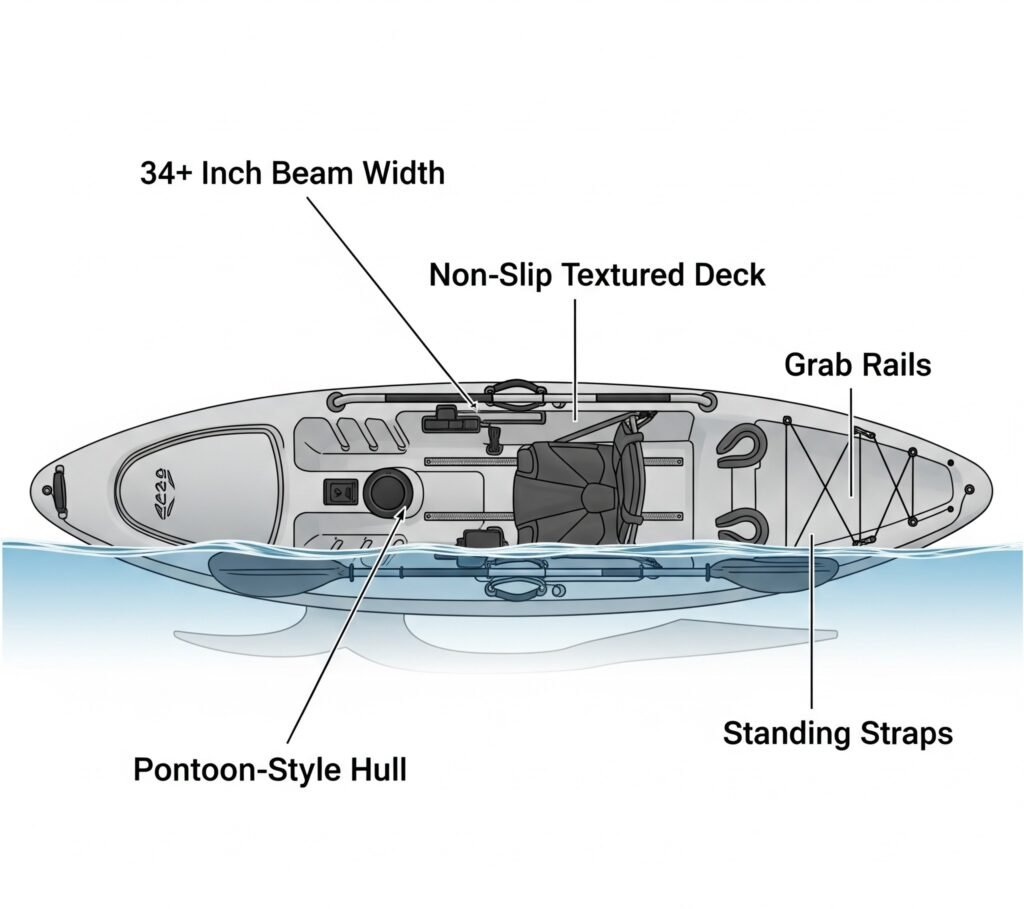
🦺 Personal Flotation Device Requirements
Always wear a properly fitted PFD when standing in a kayak. Choose inflatable or low-profile designs that don’t restrict movement while providing adequate flotation. Many experienced anglers prefer automatic inflatable PFDs that activate upon water immersion.
PFD inspection should be part of your pre-trip routine. Ensure all buckles, zippers, and inflation mechanisms function properly before heading out on the water.
🌤️ Weather Condition Guidelines
Wind and wave limits for safe standing vary by angler experience and kayak design, but general guidelines suggest avoiding standing in winds exceeding 15 mph or waves over 1 foot. Choppy conditions significantly increase the difficulty and risk associated with standing.
Weather monitoring should continue throughout your fishing trip. Conditions can change rapidly, and what starts as calm water can become dangerous for standing activities.
🚨 Emergency Procedures
Quick sitting techniques involve immediately dropping to the kneeling position when balance is compromised, then transitioning to seated position. Practice this emergency descent until it becomes automatic.
Capsizing response procedures should be practiced in controlled environments. Know how to perform a wet exit, right your kayak, and re-enter from the water. Consider taking a kayak safety course that covers these essential skills.
📱 Communication and Planning
Trip planning should include informing others of your fishing location, expected return time, and emergency contacts. Carry waterproof communication devices and consider GPS beacons for remote fishing locations.
Practice requirements suggest a minimum of 5-10 hours of controlled practice before attempting standing in fishing situations. Start in shallow, calm water near shore and gradually progress to more challenging conditions.
“Safety statistics show that 85% of kayak fishing accidents involve anglers who haven’t practiced basic safety skills in controlled environments.” – American Canoe Association
Equipment Selection and Technology Integration
🔧 Rod and Reel Considerations
Standing fishing requires specific rod and reel combinations optimized for the elevated casting position. Medium to medium-heavy rods in the 7-8 foot range provide optimal leverage and casting distance while maintaining manageable weight during extended standing sessions.
Reel selection should prioritize smooth drag systems and reliable performance, as the enhanced hook-setting power from standing positions places additional stress on tackle components. High-quality spinning reels or baitcasters with strong drag systems perform best in stand-up applications.
📡 Fish Finder Integration
Modern fish finders for kayaks provide critical information that complements the enhanced visibility from standing. Side-imaging and down-imaging technologies help identify structure and fish that may not be visible even from the elevated standing position.
GPS integration allows anglers to mark productive spots identified while standing, creating a database of fishing locations that can be revisited. The best fish finders for kayak fishing combine compact design with advanced imaging capabilities.
⚡ Power and Propulsion Systems
Electric fishing kayaks offer significant advantages for stand-up fishing by providing hands-free positioning and movement. Pedal-drive systems allow anglers to maintain position while standing, while electric motors provide quiet propulsion that doesn’t spook fish.
Battery management becomes critical when combining electric propulsion with fish finders and other electronics. Plan for sufficient power capacity to support all systems throughout your fishing day.
🎯 Specialized Accessories
Standing aids include adjustable foot braces, balance bars, and stability platforms that can be added to existing kayaks. These accessories help anglers transition to standing fishing without purchasing entirely new kayaks.
Rod management systems designed for standing fishing include elevated rod holders, quick-release mechanisms, and multi-position mounting systems that accommodate the dynamic nature of stand-up fishing.
Technique Refinement and Skill Development
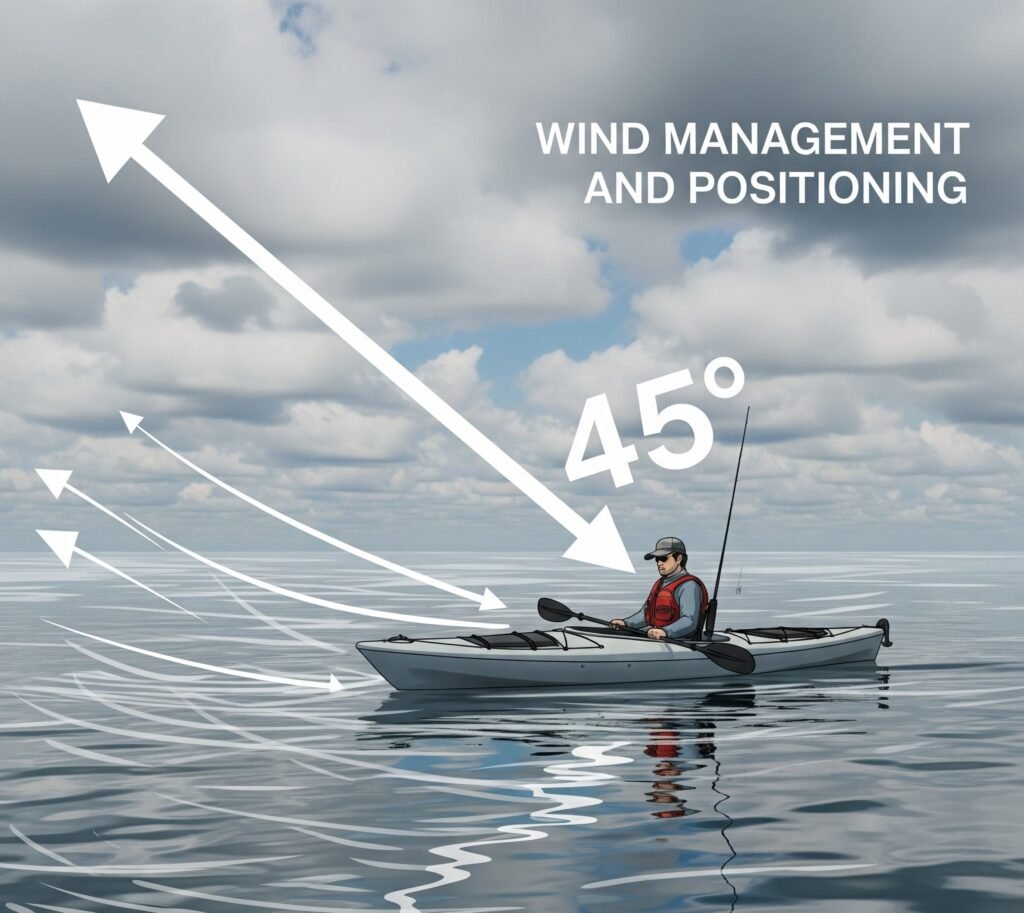
📚 Progressive Learning Approach
Skill development should follow a systematic progression from basic balance exercises to advanced fishing techniques. Start with static standing practice in calm, shallow water before attempting dynamic activities like casting or fish fighting.
Balance training exercises performed on land can accelerate your standing development. Use balance boards, stability balls, or other training tools to develop the core strength and proprioception necessary for confident standing.
🎯 Casting Technique Optimization
Standing casting mechanics differ significantly from seated techniques. The elevated position allows for longer casting strokes and greater power generation, but requires practice to master the timing and coordination.
Accuracy drills should be practiced regularly to take full advantage of the standing position’s benefits. Set up targets at various distances and practice hitting them consistently from the standing position.
🐟 Fish Fighting Strategies
Leverage techniques from the standing position allow for more effective fish control. Learn to use your full body weight and positioning to manage fish movements and maintain consistent pressure throughout the fight.
Rod angle management becomes more critical when standing, as you have greater flexibility in rod positioning. Practice maintaining optimal angles for different fish species and fighting scenarios.
Seasonal Considerations and Environmental Factors
🌡️ Temperature and Clothing
Seasonal clothing choices significantly impact standing comfort and safety. Cold weather requires additional layers that don’t restrict movement, while warm weather demands sun protection and hydration considerations.
Footwear selection plays a critical role in standing safety. Choose shoes with excellent grip, quick-drying materials, and adequate protection. Avoid smooth-soled shoes that can slip on wet kayak decks.
🌊 Water Conditions and Timing
Optimal water conditions for standing include calm surfaces, minimal current, and good visibility. Early morning and late evening often provide the best combination of calm conditions and active fish feeding.
Tidal considerations affect both water conditions and fish behavior. Plan standing fishing sessions around slack tide periods when water movement is minimal and fish are often most active.
🎣 Species-Specific Timing
Different fish species have optimal standing fishing windows. Sight fishing species like redfish and tarpon are best targeted during high-light conditions when standing visibility advantages are maximized.
Structure-oriented species benefit from the enhanced structure identification possible from standing positions, making them excellent targets throughout the day when water conditions permit safe standing.
Top Stand-Up Fishing Kayak Recommendations
💰 Budget-Friendly Options ($800-$1200)
The Pelican Catch Mode 110 represents excellent value for beginning stand-up anglers. Its 32-inch beam and stable pontoon hull design provide adequate stability for learning, while the affordable price point makes it accessible for budget-conscious anglers. Key features include multiple rod holders, storage compartments, and a comfortable seat system.
Pros: Affordable, stable platform, good storage
Cons: Limited advanced features, narrower beam than premium options
🎯 Mid-Range Excellence ($1200-$2000)
The Bonafide SKF117 delivers enhanced stability with its 34-inch beam and specialized standing platform. This kayak bridges the gap between entry-level and premium options, offering standout features like adjustable seating, multiple rod holder positions, and improved hull design for better tracking.
Pros: Excellent stability-to-price ratio, versatile design, proven performance
Cons: Heavier than some competitors, limited color options
🏆 Premium Performance ($2000+)
The Hobie Pro Angler 12 360XR represents the pinnacle of stand-up fishing kayak design. Its 38-inch beam, advanced stability systems, and comprehensive standing aids make it ideal for serious anglers. Features include the MirageDrive 360 propulsion system, extensive storage, and professional-grade construction.
The Bonafide PWR129 offers similar premium performance with its innovative hull design and extensive standing platform. Advanced features include integrated rudder systems, premium seat options, and modular accessory mounting.
Pros: Maximum stability, comprehensive features, professional performance
Cons: Higher price point, increased weight, may be overkill for casual anglers
For detailed analysis of these models, explore comprehensive reviews that provide in-depth testing results and real-world performance data.
Maintenance and Longevity
🔧 Regular Maintenance Protocols
Kayak maintenance becomes more critical when regularly standing, as the additional stress on hull and deck components requires attention. Monthly inspections should include checking for stress cracks, loose hardware, and wear patterns on standing surfaces.
Deck surface maintenance involves cleaning and treating non-slip surfaces to maintain their effectiveness. Replace worn grip tape or textured surfaces before they compromise safety.
🛠️ Upgrade and Modification Options
Aftermarket modifications can enhance existing kayaks for better standing performance. Stability upgrades include outriggers, pontoon attachments, and extended deck platforms that improve standing capabilities.
Accessory integration allows customization of rod holders, electronics mounts, and storage solutions to match individual fishing styles and preferences.
📊 Performance Tracking
Fishing logs should track standing success rates, conditions, and techniques to identify patterns and improvement opportunities. Digital tools and apps can help organize this data for better analysis.
Skill assessment should be ongoing, with regular evaluation of standing confidence, casting accuracy, and fish fighting effectiveness from the standing position.
🛶 Stand-Up Kayak Fishing Stability Calculator
Advanced Training and Skill Development Programs
🏫 Structured Learning Approaches
Professional instruction can significantly accelerate your stand-up fishing development. Many kayak fishing guides and instructors offer specialized courses focusing on standing techniques, safety protocols, and advanced fishing strategies. These programs typically include both on-water practice and classroom instruction covering theory and safety.
Certification programs through organizations like the American Canoe Association provide structured learning paths with measurable skill benchmarks. These programs ensure you develop proper techniques from the beginning, avoiding bad habits that can be difficult to correct later.
🎯 Practice Regimens and Drills
Daily balance exercises performed on land can dramatically improve your on-water standing performance. Balance board training for 10-15 minutes daily develops the core strength and proprioception necessary for confident kayak standing.
Progressive water drills should begin in shallow, calm water near shore. Start with 30-second standing sessions and gradually increase duration as confidence builds. Practice the standing transition repeatedly until it becomes automatic and smooth.
Casting accuracy drills from the standing position help maximize the benefits of elevated fishing. Set up targets at various distances and practice hitting them consistently. Track your accuracy percentage to monitor improvement over time.
📊 Performance Metrics and Goals
Measurable benchmarks help track your standing fishing development:
- Standing duration without fatigue (goal: 30+ minutes)
- Casting accuracy from standing position (goal: 80% within 2-foot target circle)
- Successful fish landings while standing (goal: 90% retention rate)
- Weather condition limits (goal: comfortable standing in 10+ mph winds)
Progress tracking through fishing logs and video analysis helps identify areas for improvement and celebrates achievements. Many anglers find that documenting their progression motivates continued skill development.
Environmental Impact and Conservation
🌱 Sustainable Fishing Practices
Stand-up kayak fishing offers unique opportunities for conservation-minded anglers. The enhanced visibility allows for more selective fishing, reducing bycatch and enabling better fish handling practices. Sight fishing from the standing position often results in higher-quality fish encounters with reduced environmental impact.
Catch and release techniques benefit from the improved leverage and control available when standing. Proper fish handling becomes easier with better positioning and reduced fight times that minimize stress on released fish.
🏞️ Habitat Awareness
The elevated perspective from standing provides excellent opportunities for habitat observation and protection. Anglers can identify sensitive areas, spawning grounds, and environmental changes that might not be visible from seated positions.
Shallow water navigation becomes more precise when standing, allowing anglers to avoid damaging sensitive bottom areas while still accessing productive fishing zones. This enhanced awareness helps protect fragile ecosystems while maintaining fishing opportunities.
📚 Educational Opportunities
Citizen science programs benefit from the enhanced observation capabilities of stand-up fishing. Many anglers contribute to fish population studies, habitat monitoring, and environmental research through their fishing activities.
Youth education programs can leverage the excitement of stand-up fishing to engage young people in conservation and outdoor recreation. The visual appeal and challenge of standing fishing often captures attention more effectively than traditional fishing methods.
Regional Considerations and Techniques
🌊 Saltwater Applications
Saltwater stand-up fishing presents unique opportunities and challenges. Sight fishing for redfish in shallow flats becomes dramatically more effective from the standing position, allowing anglers to spot fish at greater distances and make more accurate presentations.
Tidal considerations play a larger role in saltwater environments. Plan standing sessions around slack tide periods when water movement is minimal and fish are often most active in shallow areas.
Corrosion protection becomes critical for kayaks and equipment used in saltwater stand-up fishing. Regular freshwater rinses and appropriate protective treatments extend equipment life and maintain safety features.
🏞️ Freshwater Strategies
Bass fishing from the standing position allows for better structure identification and more precise presentations to cover and structure. The enhanced visibility helps identify subtle depth changes, vegetation edges, and other bass-holding features.
Lake fishing benefits from the improved casting distance available when standing, allowing anglers to cover more water and reach distant structure or feeding fish. Wind management becomes particularly important on large lakes where conditions can change rapidly.
River fishing requires additional safety considerations due to current and obstacles. Limit standing to slower sections and maintain constant awareness of downstream hazards.
🎣 Species-Specific Adaptations
Sight fishing species like tarpon, bonefish, and permit benefit most dramatically from stand-up techniques. The enhanced visibility allows for earlier fish detection and better presentation timing.
Structure-oriented species such as bass, pike, and walleye benefit from the improved structure identification possible from standing positions. Anglers can spot submerged cover, depth changes, and other fish-holding features more effectively.
Schooling species become easier to locate and follow when standing. The elevated position allows anglers to track moving schools and position for optimal presentations.
Technology Integration and Future Trends
📱 Digital Tools and Apps
Fishing apps designed for kayak anglers increasingly include features specific to stand-up fishing. GPS waypoint marking allows anglers to save productive spots identified while standing, creating databases of fishing locations.
Weather monitoring apps help determine safe conditions for standing fishing. Real-time wind and wave data enables better decision-making about when and where to attempt standing fishing.
Tide and current apps provide critical information for saltwater stand-up fishing, helping anglers time their trips for optimal conditions and fish activity.
🔬 Equipment Innovations
Stability enhancement technologies continue to evolve, with new hull designs and add-on systems improving standing capabilities. Active stability systems and gyroscopic stabilizers represent emerging technologies that may revolutionize stand-up fishing.
Smart kayak features including integrated electronics, automated positioning systems, and advanced fish finding technologies enhance the stand-up fishing experience while maintaining safety.
Lightweight materials and improved construction techniques make high-performance stand-up fishing kayaks more accessible to a broader range of anglers.
🚀 Future Developments
Electric propulsion integration continues to improve, with systems specifically designed to support stand-up fishing activities. Hands-free positioning allows anglers to maintain optimal fishing positions while standing.
Augmented reality applications may soon provide real-time information overlays visible while standing, including depth data, fish locations, and navigation information.
Community platforms connecting stand-up fishing enthusiasts continue to grow, providing opportunities for skill sharing, location information, and safety networking.
Frequently Asked Questions
For safe standing, you need a kayak with at least 34 inches of beam width. Wider kayaks (36+ inches) provide even better stability. The wider platform distributes your weight more effectively and reduces the risk of tipping when shifting your weight or casting.
Standing up in a kayak can increase your casting distance by 25-30%. The elevated position allows for better rod leverage, improved body mechanics, and the ability to generate more power through your casting motion. You’ll also have better line management and reduced drag.
Beginners should start with practicing standing in shallow, calm water while wearing a PFD. Master basic kayak stability and balance first. Begin with short standing sessions and gradually increase duration. Consider taking a lesson or practicing with an experienced angler initially.
Start in shallow water near shore, practice the “tripod” technique (two feet + paddle), keep your knees slightly bent, engage your core muscles, and practice weight shifts slowly. Begin with 30-second stands and gradually increase duration as your balance improves.
Essential safety gear includes a properly fitted PFD, whistle, bilge pump, paddle leash, dry bag for electronics, first aid kit, and communication device. Consider a GPS/fish finder and always inform someone of your fishing plans and expected return time.
Learning Progression Timeline
Select proper kayak (34″+ beam), practice basic paddling, learn entry/exit techniques, and practice sitting balance. Focus on comfortable seated fishing first.
Practice standing in shallow water, master the tripod technique, work on core stability, and practice 30-second standing sessions with paddle support.
Extend standing duration to 2-3 minutes, practice weight shifts, learn to stand without paddle support, and practice in slightly choppy conditions.
Practice casting while standing, work on maintaining balance during cast, focus on accuracy over distance, and practice with different lure weights.
Master fish fighting while standing, practice in various water conditions, work on sight fishing techniques, and develop confidence for extended standing sessions.
Seated vs Standing Kayak Fishing Comparison
| Aspect | Seated Fishing | Standing Fishing |
|---|---|---|
| Visibility Range | Standard water level view | 50% increased sight distance |
| Casting Distance | Limited by seated position | 25-30% increase in distance |
| Hook Setting Power | Moderate leverage | Superior biomechanical advantage |
| Stability | Maximum stability | Requires practice & skill |
| Energy Expenditure | Minimal fatigue | Moderate core workout |
| Fish Fighting Control | Good control | 20% better leverage |
| Learning Curve | Immediate comfort | 2-3 months to master |
| Weather Limitations | Minimal restrictions | Wind/waves limit standing |
| Catch Rate Improvement | Baseline | Up to 40% increase |
Conclusion and Next Steps
Standing up in a kayak for fishing represents a transformative approach that elevates every aspect of the angling experience. The three primary benefits—enhanced visibility for superior fish spotting, improved casting performance with increased distance and accuracy, and better fish-fighting control through superior leverage—combine to create fishing opportunities that simply aren’t available from seated positions.
Success in stand-up kayak fishing requires the right combination of proper equipment, developed skills, and safety awareness. Start with a kayak specifically designed for standing, featuring adequate beam width (34+ inches), appropriate hull design, and essential safety features. Invest time in developing your balance and technique through systematic practice in calm, controlled conditions.
Safety must remain the top priority throughout your stand-up fishing journey. Always wear a properly fitted PFD, understand your limits, and practice emergency procedures until they become automatic. The enhanced fishing capabilities mean nothing if safety is compromised.
The immediate next steps for aspiring stand-up anglers include:
- Research and select appropriate equipment from the recommended kayak models, prioritizing stability features over other considerations
- Begin practice sessions in shallow, calm water near shore, focusing on basic standing transitions before attempting fishing activities
- Develop a progressive skill-building plan that gradually increases complexity and challenge as confidence grows
- Connect with experienced stand-up fishing communities for mentorship, safety support, and location sharing
The investment in time, equipment, and skill development pays dividends through dramatically improved fishing success, enhanced safety through better situational awareness, and the pure enjoyment of mastering this challenging and rewarding technique.
Start your stand-up kayak fishing journey today by visiting Fish Master Guide for detailed kayak reviews, additional technique guides, and comprehensive equipment recommendations. The fishing season waits for no one—begin developing these game-changing skills now to maximize your success on the water.
Whether you’re targeting shallow water species that demand sight fishing precision or deep water fish that require maximum casting distance, stand-up kayak fishing provides the tools and techniques necessary to elevate your angling success to new levels.


